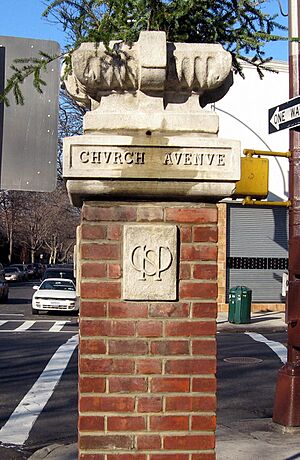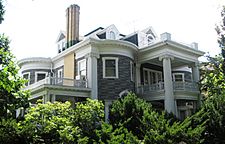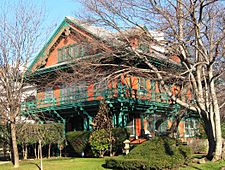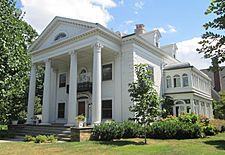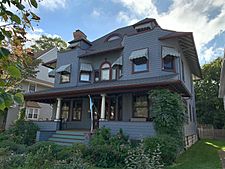Prospect Park South facts for kids
|
Prospect Park South Historic District
|
|

John S. Eakins House (1905) at 1306 Albemarle Road
|
|
| Location | Roughly bounded by BMT Brighton Line, Beverley Rd., and Coney Island and Church Aves. Brooklyn, New York City |
|---|---|
| Area | 47 acres (19 ha) |
| Built | 1899 |
| Architect | multiple |
| Architectural style | multiple |
| NRHP reference No. | 83001699 |
Quick facts for kids Significant dates |
|
| Added to NRHP | July 21, 1983 |
Prospect Park South is a special neighborhood in Flatbush, Brooklyn, New York City. It is located just south of the famous Prospect Park. This area is so unique that it is officially known as the Prospect Park South Historic District. It was recognized as a historic place by New York City in 1979. It was also added to a national list in 1983. The district is bordered by Church Avenue to the north. The BMT Brighton Line subway is to the east. Beverley Road is to the south. It lies between Stratford Road and Coney Island Avenue to the west.
The 70th Precinct of the New York City Police Department keeps Prospect Park South safe. This is the same police precinct that covers other neighborhoods in Flatbush.
Contents
History of Prospect Park South
In 1899, a builder named Dean Alvord bought about 60 acres of farmland. He wanted to create Prospect Park South. His idea was to build a community of large, beautiful homes. He called it a "rural park within the city." Alvord wanted to bring the feeling of the countryside into the city.
He chose this spot because of the train service. The Brooklyn Rapid Transit Company (BRT) had a line nearby. This line, now called the BMT Brighton Line, offered fast train service. Trains could go all the way to Manhattan by crossing the Brooklyn Bridge. This made it easy for people to live in Prospect Park South and work in the city.
Building a Dream Neighborhood
Before selling any land, Alvord prepared everything. He installed all the necessary utilities. These included water, gas, and electricity lines. He also marked the entrance of most streets. He used brick pillars with special plaques. These plaques had "PPS" carved into them.
Alvord also hired John Aitkin. Aitkin was a landscape gardener from Scotland. He was in charge of planting trees and creating beautiful lawns. He paid close attention to every detail. Trees were planted along the curb and also near the houses. This made the streets look wider. It also made each house feel like it was on its own. They used both Norway maples and Carolina poplars. Poplars grew quickly for immediate shade. Maples grew slower but provided long-term shade.
Designing the Homes
Alvord hired architect John J. Petit and his team. They designed many of the houses in the neighborhood. However, people could also hire their own architects if they wanted. Petit designed homes in many different styles. These included Colonial Revival, Tudor Revival, and Queen Anne.
The houses in Prospect Park South had to be large. They needed to be freestanding homes. Each house had to be bigger than 3,500 square feet. They also had to cost more than $5,000. Alvord had other rules for builders, too.
Alvord wanted to create a community for wealthy, well-educated families. He hoped to attract people from places like Brooklyn Heights and Manhattan. His ideas helped create a new design for modern suburbs. Other neighborhoods soon copied his style. These included South Midwood, Fiske Terrace, Ditmas Park, and the Beverley Squares. Together, these areas are now known as Victorian Flatbush.
In 1972, the Albanian community in New York built a mosque. It is located at 1325 Albemarle Road. Prospect Park South was named a historic district in 1979. This was done by the New York City Landmarks Preservation Commission.
Notable Houses in Prospect Park South
The Alvord Mansion was at 1522 Albemarle Road. Dean Alvord built it for his own family. Later, Israel Matz, who started the Ex-lax Company, bought it. The mansion burned down around 1955. This happened for unclear reasons. It was after a plan to sell it to apartment builders fell through. The community had opposed the sale.
Here are some other famous houses in the neighborhood:
- Herman Goetze House, 15 Stratford Road, 1905, Colonial Revival, George Hitchings
- Herbert Krantz House, 183 Argyle Road, 1904, Tudor Revival, John J. Petit
- George E. Gale House, 1305 Albemarle Road, 1905, Classical Revival, H. B. Moore
- John S. Eakins House, 1306 Albemarle Road, 1905, Shingle style/Colonial Revival, John J. Petit
- Col. Alexander S. Bacon House, 101 Rugby Road, Eclectic/Swiss chalet, 1900, John E. Nitchie
- Francis M Crafts House, 1423 Albemarle Road, 1899, Queen Anne, John J. Petit
- J. C. Woodhull House, 1440 Albemarle Road, 1905, Queen Anne/Colonial Revival, Robert Bryson and Carroll Pratt
- Henry P. Reade House, 1501 Albemarle Road, 1904, Queen Anne, John J. Petit
- Maurice Minton House, 1510 Albemarle Road, 1900, Colonial Revival, John J. Petit
- Louis McDonald House, 1519 Albemarle Road, 1902, Prairie School/Neo-Jacobean, John J. Petit
- Frank K. Schenck House, 219 Marlborough Road, 1900, John J. Petit
- Russell Benedict House, 104 Buckingham Road, 1902, Classical Revival, Carroll H. Pratt
- William H. McEntee House, 115 Buckingham Road, 1900, Shingle style, John J. Petit
- George U. Tompers House, 125 Buckingham Road, 1911, Colonial Revival, Brun & Hauser
- Frederick S. Kolle House, 131 Buckingham Road, 1902–03, Japanese pagoda, Petit & Green
- William A. Norwood House, 143 Buckingham Road, 1906, Italian Villa, Walter S. Cassin
- The Sovereign, 55 Parade Place, 1927, A large apartment building across from the Brooklyn Parade Grounds.
Gallery


